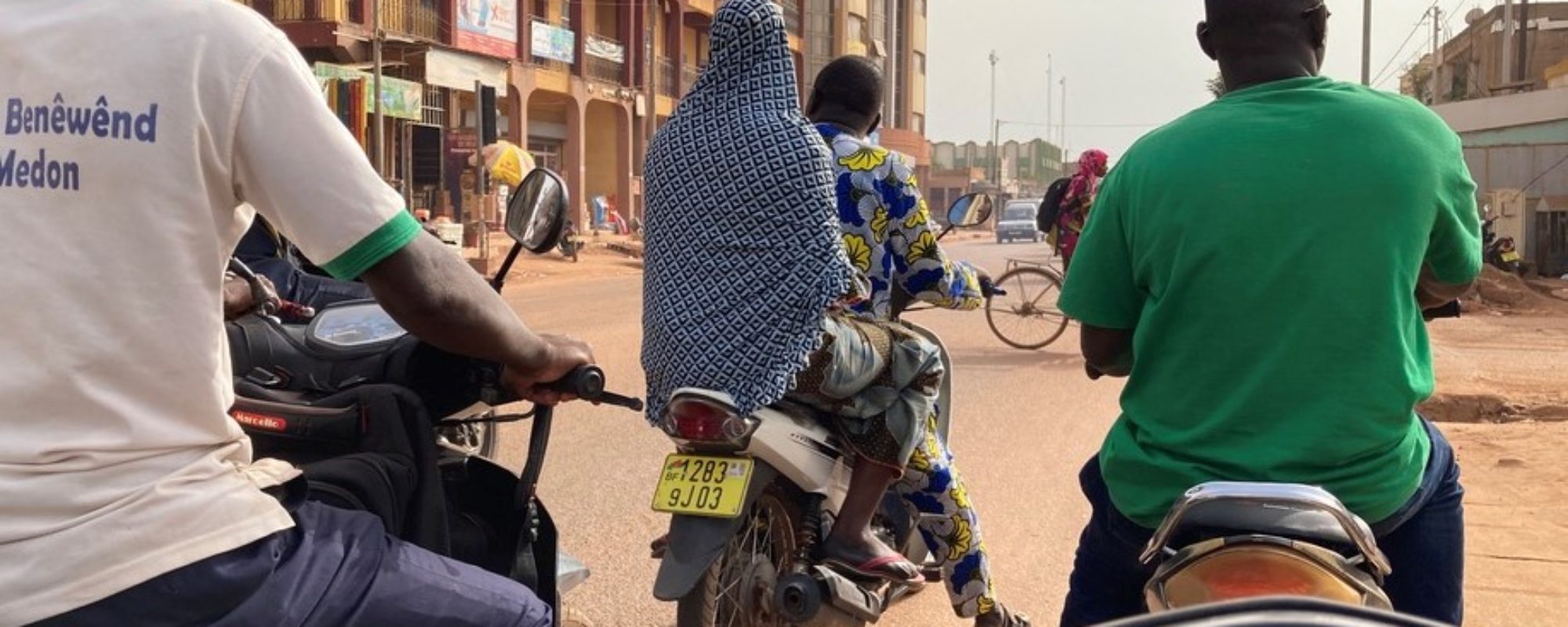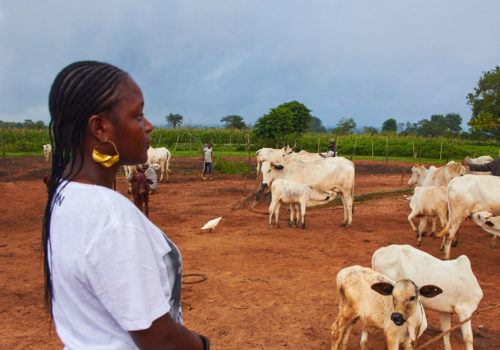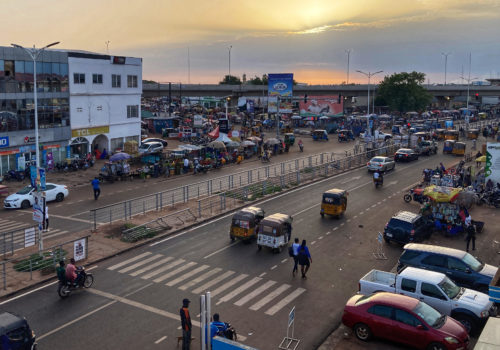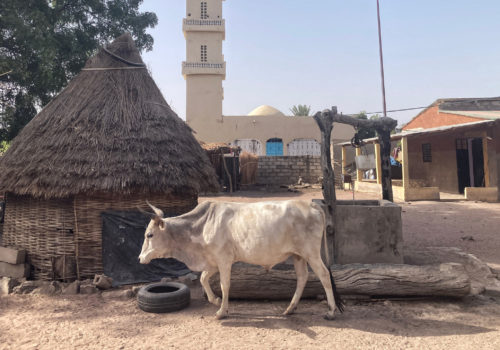OUAGADOUGOU, Burkina Faso — Weaving through the bustling traffic of Burkina Faso’s capital on my rented motorcycle, I knew I had arrived in the Hamdallaye neighborhood when I suddenly faced a small traffic jam caused by a herd of cattle crossing the road. A cramped triangular neighborhood in central Ouagadougou (pronounced wa-ga-DU-gu), Hamdallaye is populated mostly by people from the Peul ethnic group. They make up around 10 percent of Burkina Faso’s population, concentrated mostly in the country’s northern regions, and are often associated with keeping livestock and being almost exclusively Muslim.
Tidiane Tall, a tall middle-aged, light-skinned man, was born and raised in Hamdallaye. He started our tour of the neighborhood last month by introducing me to a long line of elderly men begging by the side of the road. Across the street, young women were starting cooking fires while their children ran around a gutter overfilled with refuse. Their meager possessions, wrapped in a burlap sack, were poking out from behind a nearby crumbling cement wall. “Two years ago, it was not like this,” Tall said, referring to the general urban poverty, which was more pronounced in Hamdallaye. “But since last year, almost every day more destitute people arrive fleeing the war, and even here in Hamdallaye we cannot help everyone.”
Officially, around 2 million Burkinabe, as people from Burkina Faso are known, have fled their homes due to a complex insurgency that has engulfed large tracts of the countryside. I spent two weeks in one of the few places still safe to visit, speaking with Peul from Soum province about why they fled and their experiences in the capital. The displaced people I met explained how after escaping jihadists, communal militias and a harsh government response, they have found themselves neglected by the authorities and increasingly discriminated against by surrounding communities. While potential policy changes may alleviate some of their suffering, displaced Peul civilians will struggle to eke out an existence on the margins of society until the conflict abates.
* * *
Six years ago, a rural insurgency emerged 150 miles north of Ouagadougou on the border of Mali in the province of Soum. Enflamed by a heavy-handed government response and unaccountable communal militias, the violence has since spread across the country, with Soum still at its epicenter. Hundreds of thousands of people from rural villages, small towns and the provincial (and historic) capital Djibo have been forced to flee their homes.
Before the war, Soum—whose 350,000 residents are mostly Peul and almost all Muslim—was among the poorest provinces in Burkina Faso. Apart from denizens of Djibo and a few smaller towns, most people in Soum lived in small villages without running water or electricity.[1] Almost all the local secular and religious leadership positions were held by a few elite families who also claimed ownership of all the best land. In rural areas, government agencies, where they existed, were generally perceived as corrupt or predatory.
The insurgency in Burkina Faso began in 2016 when Malam Ibrahim Dicko founded the militant jihadist group Ansaroul Islam. As a young preacher in Soum in the late 1990s and early 2000s, Dicko had amassed a number of followers by denouncing corrupt local elites and social inequalities. After fighting alongside, and being arrested with, jihadist militants in Mali, he returned to Soum in late 2015. While most of his previous followers rejected his new message—calling for a violent overthrow of the local power structures and replacing them with an Islamic utopia—a small group joined him in the forest from where they began their campaign of terror against anyone they thought would stand in their way.[2]
In 2016, Belko Sow[3], a short man from a large village a half-day bike ride from Djibo, was in his mid 50s. His elder sons had taken over the farming and herding, and as a trusted community member, he had been elected to the village development council, a body created to help the central authorities facilitate development projects in rural areas. However, Sow started becoming increasingly concerned by news of imams, teachers, judges and municipal councilors being threatened and executed by Dicko’s followers. “One morning a friend called and warned they were coming to my village next,” he recounted. “Everyone knew I had worked with the government. I fled to Djibo with my family that day.”
The security services responded to the emerging insurgency with a heavy hand. From the safety of Djibo, Sow heard that a day after the jihadists had visited his village, the army arrived and arrested three men. Their dead bodies were spotted on the side of the road a few days later. The summary executions—which disproportionately targeted Peul—are documented in a Human Rights Watch report from 2018 that quotes a village chief who suggests the government’s behavior was driving more people, particularly Peul, to the jihadists.[4]
By December 2018, 35,000 people had fled their homes in Soum due to the conflict. Most, like Sow, had gone to Djibo, where they had family and could get assistance from humanitarian organizations.[5] After staying with his brother for a few weeks, Sow got a job and found a place to rent for his two wives and five younger children on the edge of town. Life was more expensive than in the village, he said, “but at least we did not hear gunfire at night.”
While most displaced people sought shelter in Djibo, Boucari Cissé went straight to Ouagadougou. A slight quiet man in his late 30s, Cissé was born and raised in Nassoumbou, a small town in Soum 10 miles from the Malian border. Like many people in northern Burkina Faso, he spent the rainy season farming in Soum and the dry season in Ouagadougou doing odd jobs. As a young man, Cissé had counted himself among Dicko’s followers, but when the preacher returned from Mali with a more violent message, Cissé refused to join him in the forest. Following an argument with a group of those who did stay with Dicko, Cissé felt he was no longer safe in Nassoumbou and decamped for Ouagadougou.
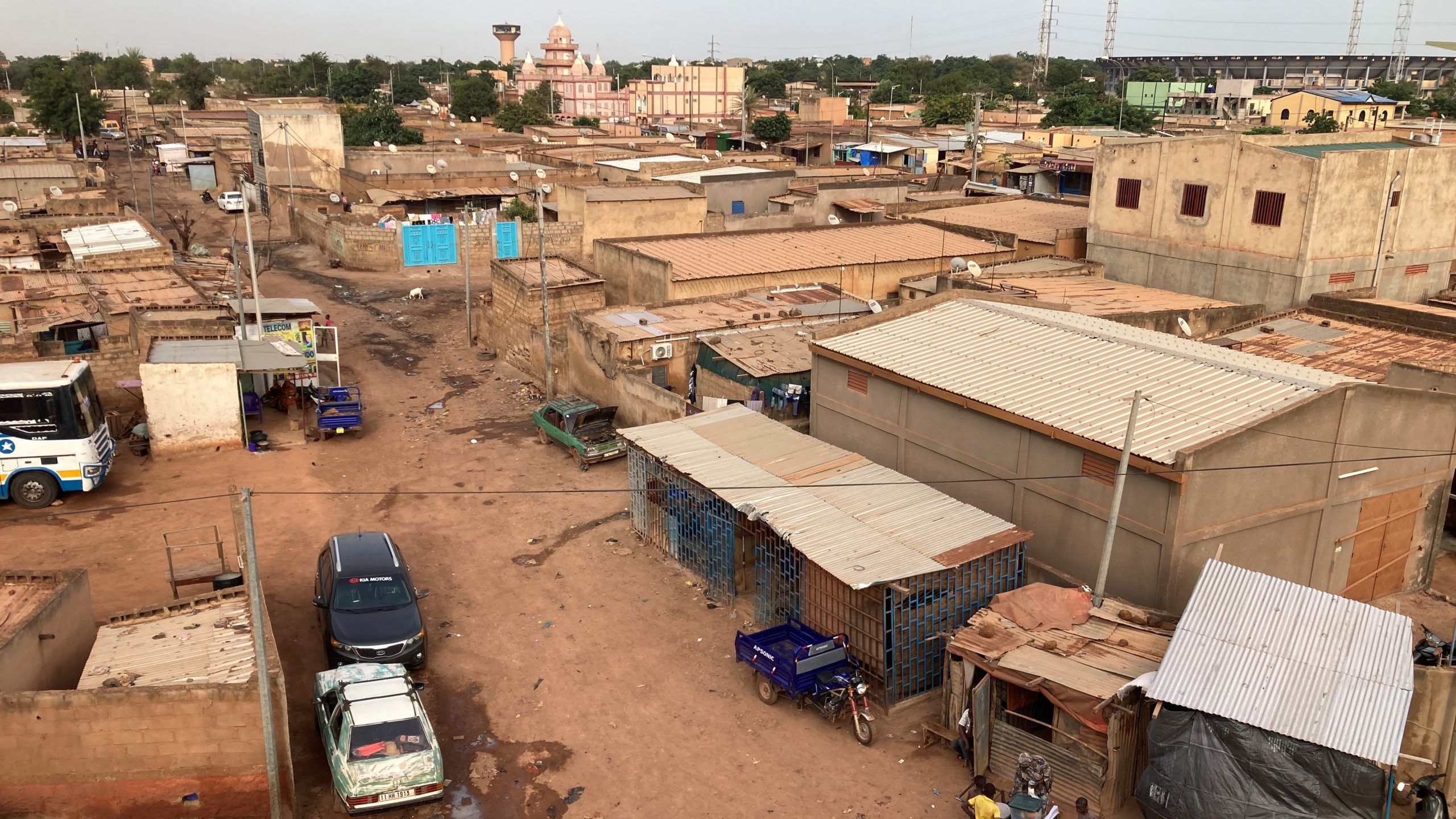
While his wife and kids stayed with family in Djibo, Cissé got a job as a guard and found a small mud brick room to rent in an expanding informal neighborhood on the southern part of Ouagadougou. He was the only Peul in the neighborhood and received no outside help. Nonetheless, he told me, he had decent relations with his new neighbors and was able to provide the basics for his family.
Aided by the experience of his previous sojourns in the city, Cissé was able to cut his own path. However, others looking for assistance with food or housing were directed to Tidiane Tall in the Hamdallaye neighborhood. Tall, mentioned earlier, was educated in Ouagadougou and neighboring Niger, worked in the Persian Gulf for a decade, then returned to Burkina Faso in 2008 to set up a company that helped Burkinabe get jobs in the Middle East.
Not long after the first displaced people from Soum began arriving in Hamdallaye, Tall helped establish the Association of Hope for Sustainable Development (AEDD in French). With funds cobbled together from wealthy Burkinabe abroad, the group was able to distribute sacks of rice and clothes to the new arrivals. “Back then, there were not many people coming to Ouagadougou so it was easier to provide for them,” he said. “But everything changed in 2019.”
* * *
Ansaroul Islam began a new offensive in Soum in early 2019, buoyed by new recruits and know-how gleaned from ties with both the regional Al-Qaeda and Islamic State franchises. After months of relentless attacks, the militants eventually overran four military bases, enabling them to assert their control over large parts of the province.[6] At the same time, Ansaroul Islam and other militant groups were expanding their operations into the east of the country, leading to an expansion of the conflict as well as the displacement crisis.
As the conflict expanded, the government began tacitly supporting communal militias that were ostensibly organizing to protect themselves amid rising insecurity. While some of the groups did fight jihadist militants, others engaged in revenge killings of Peul civilians who had been accused of aiding the jihadists. The attackers acted with impunity. The most shocking incident, mentioned by many of the Peul I spoke with in Ouagadougou, occurred in Yirgou in January 2019 when communal militias killed around 200 Peul civilians following a jihadist attack. That led to more displacement and a feeling among many Peul that they were under attack not only from the jihadists and the government but now also their neighbors.
Amid the jihadist offenses and militia attacks, the number of displaced people across the country multiplied tenfold from 50,000 to 500,000 in the space of a year.[7] Although the bulk of those fleeing conflict went to the closest regional capitals, buses carrying people from the north also began arriving regularly in Ouagadougou. There were some 5,000 IDPs in Ouagadougou in early 2019, according to the Ministry for National Solidarity and Humanitarian Action, but that is likely a vast undercount.
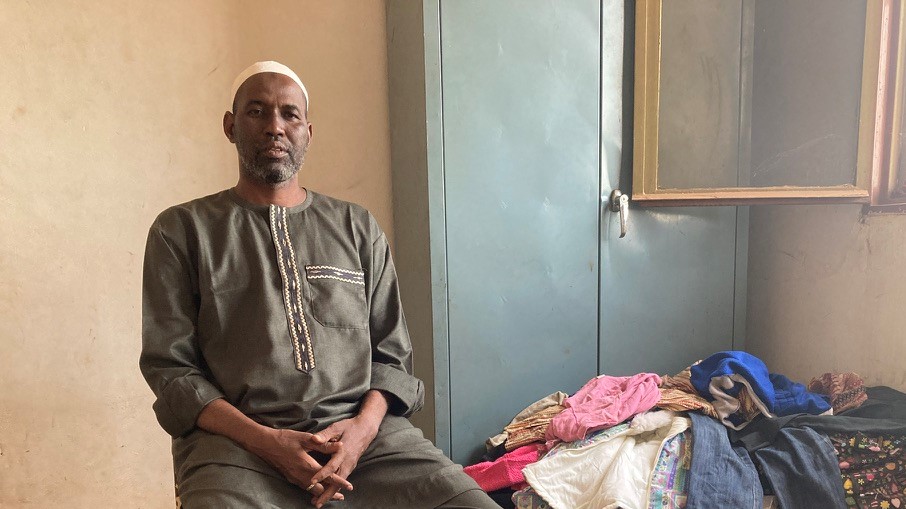
As the jihadist attacks mounted in Soum, Cissé began to receive calls from men from Nassoumbou seeking advice about how to send their wives and children to Ouagadougou. The newly displaced, many who arrived traumatized with all their belongings bundled in large mosquito nets, squatted in a nearby primary school. At first, the surrounding community helped coordinate donations of clothes and toiletries alongside government food distribution but soon the local authorities became overwhelmed and demanded the ministry act.
In June 2019, the minister in charge of humanitarian action, Laurence Marshall Ilboudo, announced that the government would no longer recognize displaced people in Ouagadougou and was instead ordering those in the capital to board buses bound for official camps in regional capitals. Humanitarian agencies, which are allowed only to distribute aid to people officially recognized by the government as “internally displaced,” were forbidden from helping in the capital. Police set up roadblocks outside the city, ordered to stop any more exiles from reaching Ouagadougou.
It is not uncommon for a government to try to deter displaced people from coming to a country’s capital. “There’s a perception that having them in your capital city makes you seem insecure,” Alexandra Lamarche, a senior fellow at Refugees International, told me over the phone, “but it is being taken to a different level in Ouagadougou.” Along with many others I spoke with in Ouagadougou, Lamarche suggested that ethnicity—the government’s not wanting a massive displacement of Peul in the capital—may have also affected the response.
Despite the deterrents, people fleeing conflict in Soum have continued to arrive in the capital. When I asked why, many told me that however precarious life is in Ouagadougou, it is safer than in the official government camps. Rumors about those sites being infiltrated by jihadists, communal militias and the government abound. It is difficult to ascertain the veracity of the allegations, partly because the government has restricted media access since October 2020. Nonetheless, there have been a handful of well-publicized cases of communal militias abducting and killing Peul civilians who were staying in official camps.
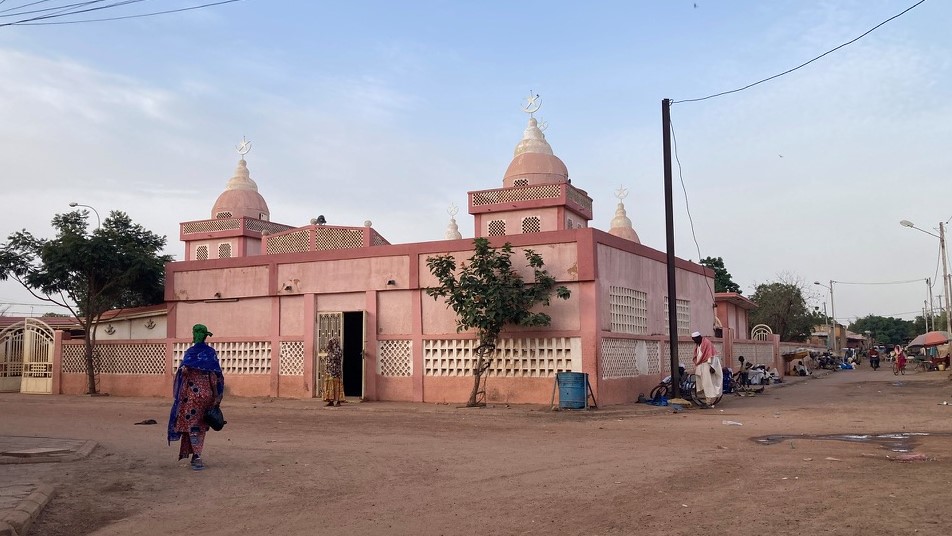
A humanitarian worker within the United Nations system in Ouagadougou who requested anonymity acknowledged problems ensuring the security of civilians fleeing conflict but insisted abductions from the camps were infrequent. When asked about the living conditions, he said the situation was dire, but pointed out that the UN was receiving only 20 percent of the funding it needed. While aware of such constraints, Lamarche from Refugees International suggested that some humanitarian organizations fear government reprisals and have shied away from grappling with the full extent of the problem.
Despite the relative safety of Ouagadougou, the majority of the displaced Peul from Soum were living in conditions of extreme hardship. The women and children who had lodged in the school by Boucari Cissé’s house were forced to leave when the school year began. Those whose husbands had arrived relocated to rented rooms in the neighborhood, others moved in with family in other parts of the city. “For us who don’t speak Moore [ Ouagadougou’s lingua-franca], we are very lonely,” Cissé’s wife, Aissatou Diallo, told me. “We are used to pulling our own water and growing our own food,” she added, “but here in Ouagadougou you have to pay for everything. Life is very hard.”
Cissé helped a number of new arrivals find jobs as guards or ditch-diggers, but even they had difficulties paying the average 8,000 West African Francs (around $12) for a room and putting enough food in the bowl for their families. Many of those without jobs have had to temporarily break up their families by sending children and wives off to relatives who could better provide for them. Cissé tried to help as much as he could, but there was little he could do as a fellow displaced person with very limited means.
In Hamdallaye, by contrast, displaced Peul from Soum were arriving in a place where everyone spoke their language and they had some kinship relations. A wealthy and well-connected sheikh allowed some to camp in his abandoned properties. At AEDD, Tall continued to distribute aid, and was even able to secure government funds by describing aid recipients as “vulnerable people” as opposed to “displaced people.”
However, while displaced people in Hamdallaye enjoyed marginally more support than those on the city’s periphery, 2019 marked a turning point in the expansion of the displacement crisis as well as regulation of the tools that could have been used to alleviate some of the suffering.
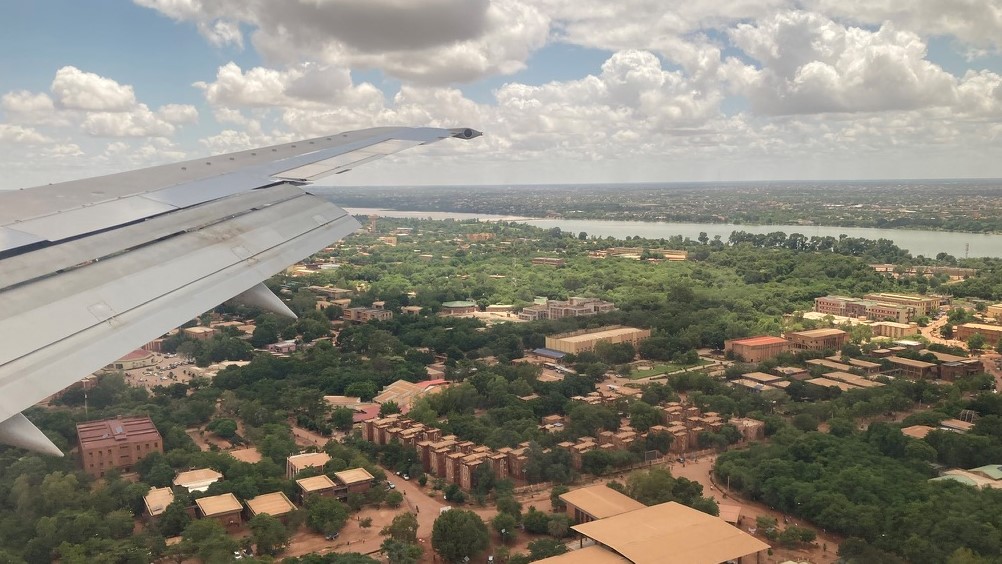
The number of Burkinabe fleeing their homes due to conflict has continued to rise since 2019. Today, 10 percent of the population is officially registered as internally displaced. While the current transitional government, installed following a military coup earlier this year, has indicated it may begin to recognize displaced people in Ouagadougou, jihadist insurgents have expanded into southern Burkina Faso, leading to even more displacements.
Violence subsided in Soum between late 2020 and mid-2021 amid a ceasefire between the government and jihadists. However, the conflict reignited earlier this year, and in February, Ansaroul Islam laid siege to Djibo following a military order preventing food and fuel from leaving Djibo. The ramification has been widespread suffering in the provincial capital, which now hosts around two thirds of the entire province’s population. Neither the monthly government convoy nor humanitarian helicopters can bring in enough food for everyone and famine conditions have emerged.[8]
By March, Belko Sow—who had fled his village for Djibo in 2017—had run out of food. “Even if you had money,” he explained, “there was nothing to buy in the market.” His wives went to stay with their families and he slipped out of town on a motorcycle under cover of darkness. He drove 70 miles on dirt paths to the city of Ouahigouya, where he boarded a bus for Ouagadougou, where he had relatives. A few weeks later, he organized a similar escape for one of his wives and two of their children.
When his wife eventually arrived in Ouagadougou, Sow brought them to the room he was renting 26 kilometers outside the city. They have no electricity or running water, and the house floods whenever it rains. They are rationing the bags of rice and oil they have been given by family members in the city. Sow has not heard from his other wife since April, when jihadists destroyed cell phone towers in Soum, plunging the province into communications darkness. “When I left, it was the beginning of famine in Djibo,” he said, worriedly. “I can only hope that my wife has enough to eat.”
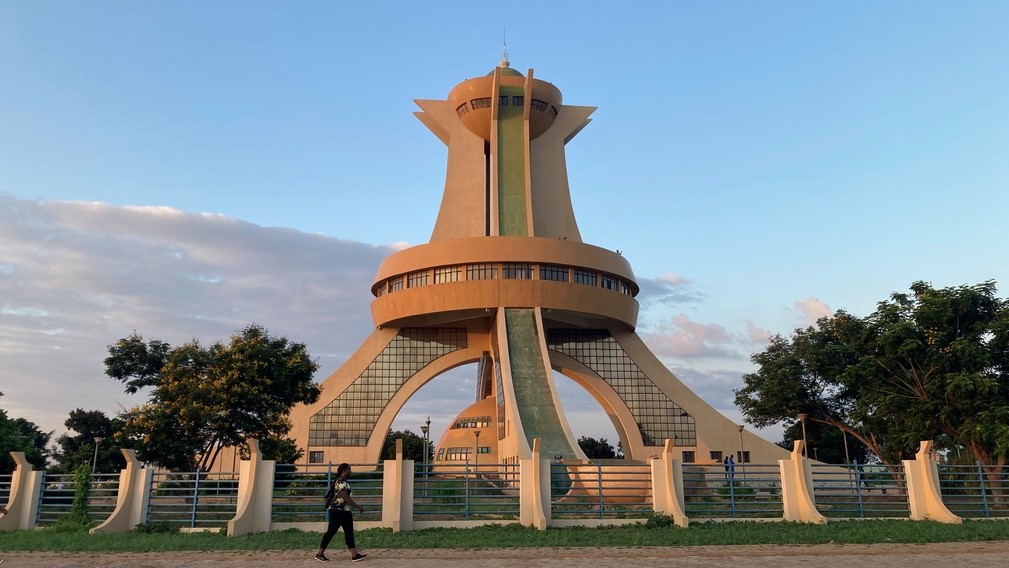
As thousands more Peul continue to be displaced, anti-Peul discrimination has become even more pronounced in the capital. Earlier this year, an audio message calling for the mass killing of Peul spread on WhatsApp. Despite saying he felt safe in his neighborhood, Boucari Cissé was arrested when someone he owed money told the authorities he was a jihadist. He spent almost a month in prison before a non-Peul neighbor vouched for him. Two other people in his neighborhood had similar stories.
During my second visit to Cissé’s house to interview displaced people, I was interrupted by the assistant to the neighborhood chief, who warned me that people thought the Fulfulde-speaking white man (me) was very suspicious and were threatening to call the gendarmes. Even after I had showed all my documents and authorizations, he advised me to leave immediately. I complied and thankfully Cissé and other Peul were not harassed. During follow-up phone calls, Cissé said the interaction was indicative of “how broken our country is… Peul cannot even sit under a tree and discuss without people getting suspicious.”
Despite the extreme difficulties faced by displaced people in Ouagadougou, Tall and the humanitarian workers I met were cautiously optimistic that the transitional authorities would change the policy regarding displaced people in the capital. The new Minister of Humanitarian Affairs, Lazare Windlassida Zoungrana, who previously led the Burkinabe Red Cross, is well-respected. Official government figures of recognized displaced people have started to include a small number of people in Ouagadougou. And Tall told me he has been in talks with the ministry since June in an effort to at least count the full number of displaced people in the capital and better coordinate aid.
When I mentioned that to some of the displaced people I met, reactions ranged from cautious optimism to cynicism. “We need any help we can get,” Cissé told me, “but the government has made many promises they have not kept.” His wife, growing tired of repeating herself, indicated that more food would put her mind at ease. However, in the next breath she added, “but we do not want to stay in Ouagadougou. If peace returns in Soum, I will return on the next bus.”
Endnotes
[1] 2017. Annuaire statistique de la région du Sahel. Ouagadougou: Institut national de la statistique et de la démographie. <http://www.insd.bf/contenu/pub_periodiques/annuaires_stat/annuaires_stat_regionaux_BF/annuaire_sahel_2017.pdf>
[2] 2017. The Social Roots of Jihadist Violence in Burkina Faso’s North. Brussels: International Crisis Group. < https://www.crisisgroup.org/africa/west-africa/burkina-faso/254-social-roots-jihadist-violence-burkina-fasos-north>
[3] All the names of displaced people have been changed to protect their identities per their requests.
[4] 2018. By day we fear the army, by night we fear the jihadists. New York: Human Rights Watch. pp. 30-31
[5] 2019. Évaluation en temps réel de l’opération de l’UNHCR et du Gouvernement sur les personnes déplacées internes. Ouagadougou: UNHCR.
[6] 2021. Sahel 2021: Communal Wars, Broken Ceasefires, and Shifting Frontlines. Armed Conflict Location Event Database
[7] 2019. Conflict, violence in Burkina Faso dsplaces nearly half a million people. UNHCR. https://www.unhcr.org/news/briefing/2019/10/5da03eee4/conflict-violence-burkina-faso-displaces-nearly-half-million-people.html
[8] 2022. Burkina Faso Food Security Outlook. Famine Early Warning systems network. https://fews.net/sites/default/files/documents/reports/BF_Food_Security_Outlook_June_2022_EN.pdf
Top photo: Riding among motorbike traffic in Ouagadougou

